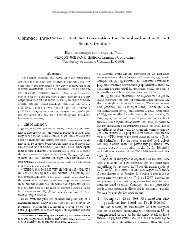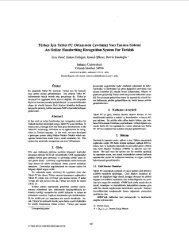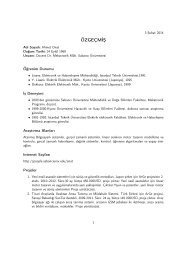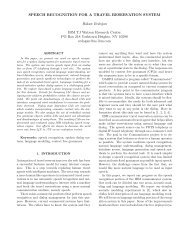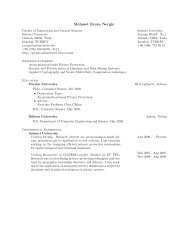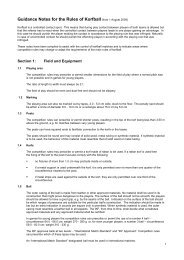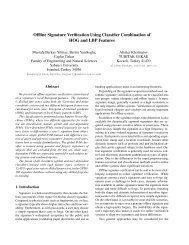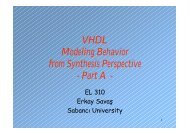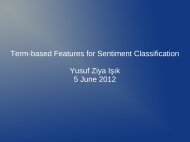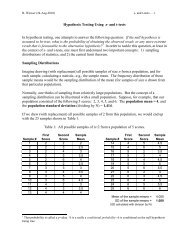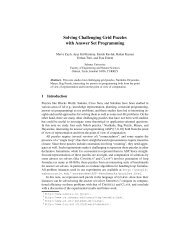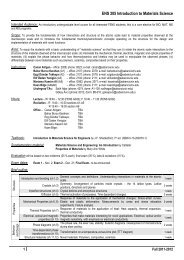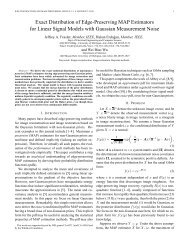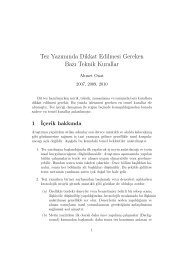( ) Robustness of Local Binary Patterns in Brain MR Image Analysis*
( ) Robustness of Local Binary Patterns in Brain MR Image Analysis*
( ) Robustness of Local Binary Patterns in Brain MR Image Analysis*
You also want an ePaper? Increase the reach of your titles
YUMPU automatically turns print PDFs into web optimized ePapers that Google loves.
symmetric neighborhood which requires <strong>in</strong>terpolation <strong>of</strong><br />
<strong>in</strong>tensity values for exact computation. In order to keep<br />
computation simple, <strong>in</strong> this study we decided to use the three<br />
rectangular neighborhoods as shown <strong>in</strong> Fig. 2.<br />
g<br />
c<br />
LBP<br />
8,1<br />
g<br />
c<br />
LBP<br />
A. Rotation Invariant <strong>Patterns</strong><br />
The LBP<br />
P ,<br />
operator can produce 2 P different output values<br />
R<br />
from the P neighbor pixels. As g is always assigned to be<br />
0<br />
the gray value <strong>of</strong> neighbor to the right <strong>of</strong> g , rotation will<br />
result <strong>in</strong> a different LBP<br />
P ,<br />
value for the same b<strong>in</strong>ary<br />
R<br />
pattern. One way to elim<strong>in</strong>ate the effect <strong>of</strong> rotation is to<br />
perform a bitwise shift operation on the b<strong>in</strong>ary pattern P-1<br />
times and assign the LBP value that is the smallest, which is<br />
ri<br />
now referred to as LBP ,<br />
(Fig. 3).<br />
P R<br />
B. “Uniform” <strong>Patterns</strong><br />
16,2<br />
A b<strong>in</strong>ary pattern is called “uniform” if it conta<strong>in</strong>s at most<br />
2 spatial transitions (bitwise 0/1 changes) [1]. Based on this<br />
riu2<br />
uniformity concept, a new LBP value ( LBP ) can be<br />
c<br />
P,<br />
R<br />
computed by summ<strong>in</strong>g the bit values <strong>of</strong> a rotation <strong>in</strong>variant<br />
b<strong>in</strong>ary pattern if it is uniform, or a miscellaneous label P+1<br />
g<br />
c<br />
LBP<br />
24,3<br />
Fig. 2. The rectangular neighborhoods <strong>of</strong> LBP used <strong>in</strong> this study.<br />
Gray-shaded rectangles refer to the pixels belong<strong>in</strong>g to the<br />
correspond<strong>in</strong>g neighborhood.<br />
00011110 2 = 30<br />
00111100 2 = 60<br />
01111000 2 =120<br />
11110000 2 =240<br />
11100001 2 =225<br />
11000011 2 =195<br />
10000111 2 =135<br />
00001111 2 = 15<br />
LBP<br />
ri<br />
8 ,1<br />
=<br />
Fig. 3. Example <strong>of</strong> comput<strong>in</strong>g rotation <strong>in</strong>variant LBP.<br />
LBP 1<br />
ri<br />
spatial<br />
8 ,<br />
transitions<br />
15<br />
LBP<br />
00000000 2 0 0<br />
11111111 2 0 8<br />
00000001 2 2 1<br />
00000011 2 2 2<br />
00001011 2 4 9<br />
riu<br />
2<br />
8,1<br />
Fig. 4. Example <strong>of</strong> comput<strong>in</strong>g rotation <strong>in</strong>variant and uniform LBP.<br />
can be assigned if it is nonuniform (Fig. 4).<br />
In this study, robustness <strong>of</strong> simple ( LBP<br />
P ,<br />
), rotation<br />
R<br />
ri<br />
<strong>in</strong>variant ( LBP<br />
P ,<br />
), and rotation <strong>in</strong>variant and uniform<br />
R<br />
riu2<br />
( LBP<br />
P,<br />
R<br />
) LBP features at three different rectangular<br />
neighborhoods (Fig. 2) are tested relative to bias field and<br />
rotation.<br />
III. APPLICATIONS OF LBP TO <strong>MR</strong> BRAIN IMAGE ANALYSIS<br />
In <strong>MR</strong>I patient is subjected to different magnetic fields at<br />
specific orientations. The protons (hydrogen atoms) <strong>in</strong> the<br />
patient’s body respond to these fields by differential decay<br />
and recovery signals, which are acquired by the <strong>MR</strong> mach<strong>in</strong>e<br />
and then converted to high contrast images. Due to factors<br />
like poor radio-frequency gradient uniformity, static field<br />
<strong>in</strong>homogeneity, radio-frequency penetration, gradient-driven<br />
eddy currents, and patient anatomy and position, pixel<br />
<strong>in</strong>tensities <strong>in</strong> <strong>MR</strong> images smoothly vary. This variation,<br />
known as <strong>in</strong>tensity <strong>in</strong>homogeneity/nonuniformity or bias<br />
field, has little impact on visual diagnosis, but its impact on<br />
the performance <strong>of</strong> automatic segmentation methods can be<br />
catastrophic due to <strong>in</strong>creased overlaps between <strong>in</strong>tensities <strong>of</strong><br />
different tissues.<br />
Furthermore, acquisition times <strong>of</strong> <strong>MR</strong>I are generally <strong>in</strong> the<br />
order <strong>of</strong> 10-20 m<strong>in</strong>utes, dur<strong>in</strong>g which patients (especially<br />
those with Park<strong>in</strong>son’s disease) tend to move that results <strong>in</strong><br />
spatially misaligned images. A common solution for this<br />
problem is registration, which may not be favored <strong>in</strong> some<br />
applications due to its computational expense and<br />
complexity. Hence, textural descriptors for <strong>MR</strong> images that<br />
are consistent <strong>in</strong> vary<strong>in</strong>g <strong>in</strong>tensities as well as geometric<br />
transformations like rotation will be very valuable.<br />
A. Experimental Data<br />
IV. RESULTS<br />
The database used <strong>in</strong> this study consists <strong>of</strong> dual (T2 and<br />
Proton Density) <strong>MR</strong> scans from 549 subjects, which are<br />
acquired on a Philips Intera 1.5T whole body scanner at<br />
Leiden University Medical Center. We used dual-sp<strong>in</strong> echo<br />
weighted images (TR/TE1/TE2: 3000/27/120 ms, FLIP: 90)<br />
with 220mm FOV, 3mm slice thickness, no slice gap and<br />
256x256 matrix.<br />
In order to test robustness <strong>of</strong> LBP with respect to <strong>in</strong>tensity<br />
variations, three simulated bias fields from the Bra<strong>in</strong>Web<br />
<strong>MR</strong> simulator [10] are used (Fig. 5). These bias fields<br />
provide smooth variations <strong>of</strong> <strong>in</strong>tensity across the image.<br />
Furthermore, we applied l<strong>in</strong>ear transformation to obta<strong>in</strong> a<br />
new bias field <strong>of</strong> each with 10%, 20%, 30% and 40%<br />
A B C<br />
Fig. 5. Examples <strong>of</strong> simulated bias fields used <strong>in</strong> this study, where<br />
<strong>in</strong>tensity variations are exaggerated for visual purposes.



